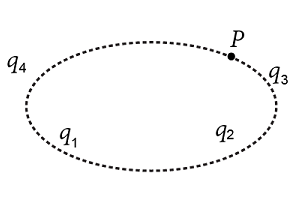
A Gaussian surface encloses two of the four positively charged particles. The particles that contribute to the electric field at the point P on the surface are:

A. ${{q}_{1}}\;and\;{{q}_{2}}$
B. ${{q}_{2}}\;and\;{{q}_{3}}$
C. ${{q}_{1}}\;and\;{{q}_{3}}$
D. ${{q}_{1}}\;,{{q}_{2}},{{q}_{3}}\;and\;{{q}_{4}}$

Answer
579.6k+ views
Hint: Use the expression for electric field due to a discrete charge distribution.
Formula used: \[\overrightarrow{E}=\sum\limits_{i=1}^{4}{\dfrac{{{q}_{i}}}{4\pi {{\epsilon }_{0}}r_{i}^{3}}\overrightarrow{{{r}_{i}}}}\]
$\overrightarrow{E}$ is the electric field at the point P due to all the charges
${{q}_{i}}$ are the four charges
$\epsilon_0$ is the permittivity of free space
$\overrightarrow{{{r}_{i}}}$ is the position vector of the point P with respect to the ${{q}_{i}}$ charge
Complete step by step solution:
According to the formula, the electric field at any point is due to the cumulative effect of all the charges present irrespective of the Gaussian surface. Hence, all the four charges ${{q}_{1}},{{q}_{2}},{{q}_{3}}\;and\;{{q}_{4}}$ will contribute to the electric field.
The correct answer is option D.
Additional information:
Coulomb’s law can be derived from Gauss’s law and vice versa. It is one of Maxwell's four equations of electromagnetic interaction. It can be used to find the electric field due to discrete and continuous charge distributions.
Electric field arises due to static charges whereas the magnetic field arises due to dynamic charges. Both are manifestations of the electromagnetic force which is one the fundamental interactions existing in nature. The electromagnetic interaction is mediated by the massless photons. The other fundamental interactions are the gravitational force, the strong nuclear force and the weak nuclear force. The strong interaction is mediated by gluons and the weak interaction is mediated by the W and Z bosons.
Note: The electric flux passing through the point P will be dependent on the Gaussian surface and the charges it encloses, consistent with Gauss’s law. Hence, only the charges q1 and q2 will contribute to the electric flux in this region.
Formula used: \[\overrightarrow{E}=\sum\limits_{i=1}^{4}{\dfrac{{{q}_{i}}}{4\pi {{\epsilon }_{0}}r_{i}^{3}}\overrightarrow{{{r}_{i}}}}\]
$\overrightarrow{E}$ is the electric field at the point P due to all the charges
${{q}_{i}}$ are the four charges
$\epsilon_0$ is the permittivity of free space
$\overrightarrow{{{r}_{i}}}$ is the position vector of the point P with respect to the ${{q}_{i}}$ charge
Complete step by step solution:
According to the formula, the electric field at any point is due to the cumulative effect of all the charges present irrespective of the Gaussian surface. Hence, all the four charges ${{q}_{1}},{{q}_{2}},{{q}_{3}}\;and\;{{q}_{4}}$ will contribute to the electric field.
The correct answer is option D.
Additional information:
Coulomb’s law can be derived from Gauss’s law and vice versa. It is one of Maxwell's four equations of electromagnetic interaction. It can be used to find the electric field due to discrete and continuous charge distributions.
Electric field arises due to static charges whereas the magnetic field arises due to dynamic charges. Both are manifestations of the electromagnetic force which is one the fundamental interactions existing in nature. The electromagnetic interaction is mediated by the massless photons. The other fundamental interactions are the gravitational force, the strong nuclear force and the weak nuclear force. The strong interaction is mediated by gluons and the weak interaction is mediated by the W and Z bosons.
Note: The electric flux passing through the point P will be dependent on the Gaussian surface and the charges it encloses, consistent with Gauss’s law. Hence, only the charges q1 and q2 will contribute to the electric flux in this region.
Recently Updated Pages
Two men on either side of the cliff 90m height observe class 10 maths CBSE

What happens to glucose which enters nephron along class 10 biology CBSE

Cutting of the Chinese melon means A The business and class 10 social science CBSE

Write a dialogue with at least ten utterances between class 10 english CBSE

Show an aquatic food chain using the following organisms class 10 biology CBSE

A circle is inscribed in an equilateral triangle and class 10 maths CBSE

Trending doubts
Why is there a time difference of about 5 hours between class 10 social science CBSE

Write a letter to the principal requesting him to grant class 10 english CBSE

What is the median of the first 10 natural numbers class 10 maths CBSE

The Equation xxx + 2 is Satisfied when x is Equal to Class 10 Maths

Which of the following does not have a fundamental class 10 physics CBSE

State and prove converse of BPT Basic Proportionality class 10 maths CBSE




